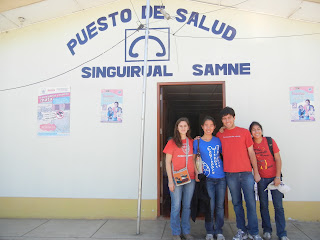Now that Tom and I (the last of the tech team) have made it home, it seems a good time to go over what we accomplished along with Leo and Emily during the past three weeks. In this time, we all have been busy getting our hands dirty in trash, sewage and cold, hard science (all while wearing gloves and sometimes Tyvek suits, of course). Here’s a rundown:
1. Trash Characterization
Starting off, we were interested in two projects: a sanitary landfill and a sewage system. So, we began our trip by scouting and discovering Samne’s current systems in place of these. What we found was pretty surprising. For trash, there were a total of 8 sites totaling an estimated 225 cubic meters of trash dumped around the town! Most of these sites were cliffs alongside the Rio Moche where people would just simply come by to toss trash. Foul smell and insects invariably accompanied. Foul smell and insects that we ignored while digging through the trash to characterize and weigh it. Our valiant and somewhat grimy efforts showed us that most of the waste is plastic, though everything from organics to med-waste was found dumped at the sites around town. Some seemed to be regularly burned while others seemed to still have waste from a while back. Out of sight, out of mind was clearly the general perspective on trash.
Sewage dumpsites were very similar. The pipes going through town were all dumped out through three open pipes at the edge of town. Tests with the Imhoff Cone showed a definite presence of “settleable solids” (read: “poop”). A couple other tests confirmed contamination and no means of treatment. A trip to a nearby small city, Otuzco, a couple days later, however, informed us that government plans to develop a sewage treatment system by oxidation ponds have been confirmed. Though not the most efficient or effective method, this is a definite step in the right direction; however, it means that we handled dirty sewage water while the problem is already being taken care of. Well, we got some useful information about the town, and only one of us got sewage on himself (cough, Leo).
3. River Water Testing
Considering all of these dump sites along with the decades of mining waste dumped upstream of Samne, we decided it was also important to test the water quality of the Rio Moche both upstream and downstream of the pueblo. What we found was that the river water was hard and alkaline with a high pH – all corresponding results. Interestingly, other tests such as those for nitrates and phosphates did not yield extraordinary results. This meant that the river was not polluted in some of the ways we expected. Looking inside and even overturning rocks, however, showed that there were no signs of life except in still ponds where another water source flowed in. Talking to the people of Samne, we learned that some generations ago, the same river was teeming with fish all year long. This tells us that chemicals (possibly arsenic or mercury) for which we did not have testing materials have polluted the river over the years and made it unsuitable for marine life.
4. Samne Drinking Water Analysis
We also conducted similar water tests on the drinking water of Samne once we started talking to the community and considering other community projects. Somewhat disturbingly, we found traces of fecal coliform in the drinking water. Turns out that regularly boiling drinking water was probably a good decision on our part! We also oversaw the routine maintenance of the water source and got a look at their spring boxes and reservoirs. Apparently, the town currently dumps chlorine into the water once a month, all at once. Monitoring the chlorine levels showed us that the day this was done, the levels were out of control. Just two days later, though, there was almost no residual chlorine left. Changes clearly need to be made to this system. One interesting observation this brings up is that while the townspeople of Pitajaya, who get their river from the contaminated Rio Moche, say they try to chlorinate when they can, their system must be even less effective. All the more confirmation of the urgency of a potable water project there.
5. Bridge Diagramming
After realizing how important a more stable bridge, another possible project, will be to the town’s future growth, we also analyzed and diagrammed the current bridge. Though we were convinced of its terrible condition after seeing it dip in a sinusoidal manner every time a car went over it, we actually found that the parts were not rusted and seemed well maintained. The problem seems to be that it was not built for heavy cars to go over it and its 5-ton weight limit (according to Alan, the town mayor) is neared by the combis (small busses) that pass it daily.
6. Soil Testing
Finally, we also ran infiltrometer tests on beds of clay soil on plateaus right next to Samne. The low permeability of the soil we found there showed that they could serve as great liner material when a sanitary landfill project is undertaken in the community. Though the land does not belong to Samne, if these locally available materials can be used, it will make the project less expensive and more viable.
Overall, our work confirmed the necessity and viability of a number of projects in the town. As Samne develops, all the projects we have looked into will eventually need to be completed. Whether we work on them in our five years here or another group completes them at a later time, the data we have collected should provide a solid foundation for development. Meanwhile, we all had a blast hiking through the Andes and the Rio Moche to get data, all while being a part of some real life, outdoor scientific action!



















